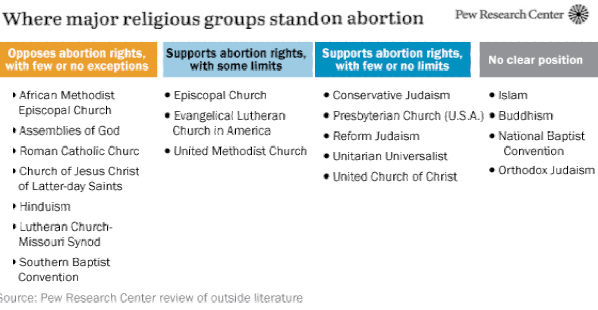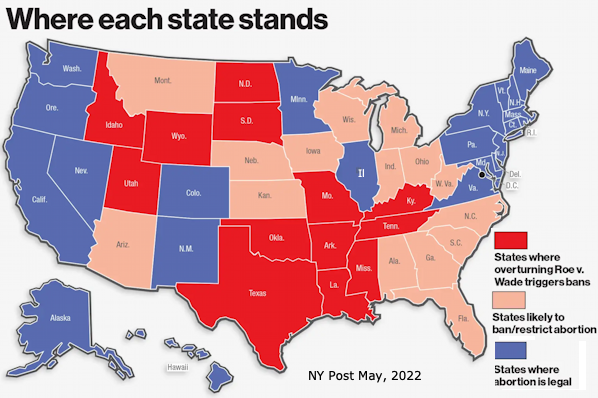 Politics
Politics
 Abortion
Abortion
Don's Home
 Politics
Politics
 Abortion Abortion
| Contact |
However there is another argument.
Does abortion reduce crime? There is considerable evidence for this.
See Abortion and Crime below:
Contents: Supreme Court Decisions | When does life start? | Abortion Methods | Terms: | What the Bible Says: | Religious Guidelines: | State Laws: | Abortion and Crime
Supreme Court decisions:
In 1973 The Supreme Court decision Row vs Wade limited state's right to regulate abortion.
In 1992 Planned Parenthood v. Casey the court upheld Roe
In 2022 In Dobbs v. Jackson Womens Health Organizationa a conservative court overturned Row.
Pregnancy Detection:
The first sign of pregnancy is often a missed period, which happens around 15 days past ovulation (DPO). Some women may notice symptoms as early as 5 DPO, although they wont know for certain that they are pregnant until much later.
There are various other signs of pregnancy such as:
Cramping
Raised basal body temperature
...
As soon as the fertilized egg implants into the uterine wall, a pregnancy hormone called human chorionic gonadotropin (hCG) is produced.
. This means a high-quality pregnancy test could detect a pregnancy in as little as five days after conception.
There are claims that home pregnancy tests are 99% accurate, but its important to know the percentage of accuracy is not that high when the test is taken right at the time of a missed period.
According to the American Pregnancy Association, blood tests for hCG levels should be accurate 11 days after conception, while it would be best to wait 1214 days before taking a urine test.
Early signs of pregnancy can be easy to miss, especially if the person has not been pregnant before.
See 5 DPO: Early symptoms and when to take a pregnancy test
Heartbeat: Gestational Age Week 7 (Fetal Age: 5 weeks)
Some laws limit abortion after heartbeat.
Many have criticized these because many women do not know they are pregnant until after this time.
2. Second-trimester abortions have been inaccurately called late-term abortions. But thats a confusing term because the medical definition of late term refers to pregnancy not abortion.
3. Late-term is a medical term used to describe the very end of a pregnancy, after it has reached full term, from week 41 onward.
The latest point in pregnancy that you can have an abortion in the U.S. is 24 weeks.
See What Is a Late-Term Abortion, and What Is the Timeline? - GoodRx
In a town hall with Chris Wallace during the 2020 presidential campaign Pete Buttigieg put it into perspective.
"I think the dialogue has gotten so caught up on where you draw the line, that we’ve gotten away from the fundamental question of, who gets to draw the line? "
See What Pete Buttigieg's Late Term Abortion Comments Mean For Families
Row vs Wade specified that after viability, which includes the third trimester of pregnancy and the last few weeks of the second trimester, abortions could be regulated and even prohibited, but only if the laws provided exceptions for abortions necessary to save the "life" or "health" of the mother.
Half of abortions are now done with medication which is safe up to 10 weeks.
There have been bans on certain types of abortion. e.g.
Partial-Birth Abortion Ban Act 2003 - Wikipedia
The anti abortion argument uses Jeremiah 1:5 "Before I formed you in the womb I knew you, before you were born I set you apart".
Religious Guidelines:

Source: Where major religious groups stand on abortion | Pew Research Center, 2016
Islam
The Quran does not directly address intentional abortion, leaving greater discretion to the laws of individual countries..
There are four Sunni Islam schools of thought—Hanafi, Shafi‘i, Hanbali and Maliki—and they have their own reservations on if and when abortions can happen in Islam. It depends on when ensoulment occurs
Hanafi - 120 days.
Shafi - 80 days
Maliki and Hanbali - 40 days
See:
Islam and abortion
Judaism:
Orthodox Judaism opposes most abortion, but permits it when the pregnancy endangers the woman's life.
Judaism and Abortion by the National Council of Jewish Women says.
'Sources in the Talmud note that the fetus is "mere water"
before 40 days of gestation. Following this period, the fetus is considered a physical part of
the pregnant individual’s body, not yet having life of its own or independent rights. The fetus
is not viewed as separate from the parent’s body until birth begins and the first breath of
oxygen into the lungs allows the soul to enter the body.'
The Presbyterian (U.S.A) churches guidelines have generally been liberal during my lifetime.
"Currently the PC(USA)'s Social Justice and Peacemaking Unit works with the interdenominational Religious Coalition for Reproductive Choice."
The now-Advocacy Committee on Women's Concerns will bring up a overture on reproductive justice at the 225th General Assembly in 2022.
See Presbyterian Church (U.S.A.) - Reproductive justice and the PC(USA)
Note: The Presbyterian (U.S.A) is the largest Presbiterian denomination with about 1.2 Million members, but shrinking as Presbyterian churches leave to join other more evangelical/conservative Presbyterian denominations, primarily over same-sex marriage and related issues.
The Evangelical Presbyterian churches who oppose same-sex marriage are also pro-life. They are (membership):
Presbyterian Church In America (378K)
EPC - Evangelical Presbyterian Churches"(145K)
ECO - Evangelical Covenant Order of Presbyterians (130K)

See:
Pregnancy in health
Rights and the Supreme Court
What Is a Late-Term Abortion, and What Is the Timeline? - GoodRx
Islam and abortion - Wikipedia
Sources:
Freakonomics podcast Episode 384 "Abortion and Crime Revisited", October 28, 2024.
It is an update of a 2019 episode with updated references.
From the 1960 - 1990 violent crime was rising. In the early 1990's violent crime started to decline. There were many theories, better policing, re-introduction of the death penalty, stronger economy, demise of the crack epidemic. There are ways to test correlation with each of these. e.g. compare states with the death penalty vs those without, but together they only accounted for half of the decrease in crime.

Some academics noticed that after legalization of abortion 17 years earlier (Supreme Court decision Roe vs Wade) in 1973) the abortion rate went up to 345 abortions per 1,000 live births. (Economists love to look at data that have significant changes and keep files on these things)
They wondered if there was any correlation.
They came up with a hypothesis that children who were unwanted/un-loved were more likely to become criminals startin their late teens.
Abortion in lower social-economic families reduced the number of these kids. The abortion rate for unmarried women was also higher.
They found a lot of variables which supported their hypothesis.
States with more pro-choice laws had a lower crime rate and abortion accounted for 80% - 90% of the drop in crime. They published this in a 2014 paper.
Several researchers studied this and published a paper in The Quarterly Journal of Economics that documented abortion accounted for up to a 50% of the reduction in crime nationally.
There was a lot of criticism of this for political and other reasons. People claiming things like it promoted eugenics (controlled reproduction). They of course denied this, as economists they were just pointing out some potential cause-effect.
They argued it said it pointed to women making good choices on child birth.
It does not affect the anti-abortion argument that a fetus is a living person.
They pointed out that reducing unwanted pregnancies was a better solution to the crime problem, which has been shown in the Netherlands.
There was also a mistake in one table they added at the last minute at the request of a reviewer.
It was revised in 2021 paper to correct the mistake and showed an even stronger argument for their conclusion.
See Transcript of 2024 Freakonomics updated podcast on YouTube
SOURCES: